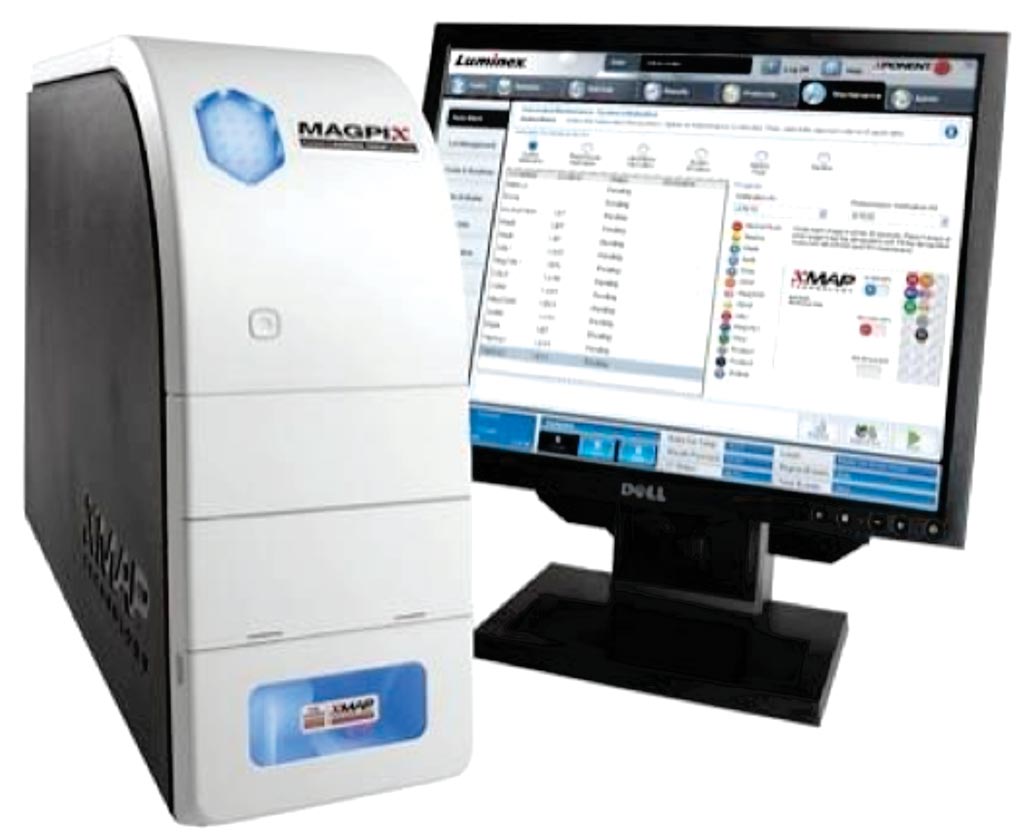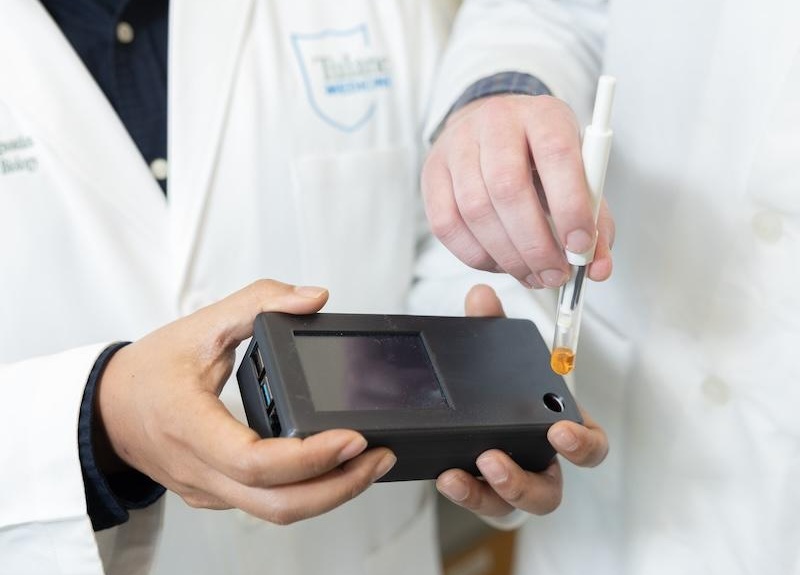Biomarker Low Predictive Power Validated for eGFR Decline
|
By LabMedica International staff writers Posted on 06 Sep 2018 |

Image: The MAGPIX clinical multiplexing analyzer system (Photo courtesy of Luminex).
Glomerular filtration rate (GFR) is a measure of the function of the kidneys. This test measures the level of creatinine in the blood and uses the result in a formula to calculate a number that reflects how well the kidneys are functioning, called the estimated GFR or eGFR.
The decline of estimated glomerular filtration rate (eGFR) in patients with type 2 diabetes is variable, and early interventions would likely be cost-effective. The contribution of 17 plasma biomarkers to the prediction of eGFR loss on top of clinical risk factors has been elucidated.
A large team of scientists collaborating with the Medical University of Vienna (Vienna, Austria) studied participants in PROVALID (PROspective cohort study in 2,560 patients with type 2 diabetes mellitus for VALIDation of biomarkers), a prospective multinational cohort study of patients with type 2 diabetes and a follow-up of more than 24 months; (baseline median eGFR, 84 mL/min/1.73 m2; urine albumin-to-creatinine ratio, 8.1 mg/g). The 17 biomarkers were measured at baseline in 481 samples using Luminex and enzyme-linked immunosorbent assays (ELISA). The prediction of eGFR decline was evaluated by linear mixed modeling.
The investigators reported that in univariable analyses, nine of the 17 markers showed significant differences in median concentration between stable and fast-progressing patients. A linear mixed model for eGFR obtained by variable selection exhibited an adjusted R2 of 62%. A panel of 12 biomarkers was selected by the procedure and accounted for 34% of the total explained variability, of which 32% were due to five markers. These five biomarkers include Kidney injury molecule 1 (KIM1), Fibroblast growth factor 23 (FGF23), N-terminal pro b-type natriuretic peptide (NTproBNP), hepatocyte growth factor (HGF), and matrix metalloproteinase-1 (MMP1).
The individual contribution of each biomarker to the prediction of eGFR decline on top of clinical predictors was generally low. When included into the model, baseline eGFR exhibited the largest explained variability of eGFR decline (R2 of 79%), and the contribution of each biomarker dropped below 1%.
The authors concluded that in their longitudinal of patients with type 2 diabetes and maintained eGFR at baseline, 12 of the 17 candidate biomarkers were associated with eGFR decline, but their predictive power was low. Given the inferior performance of this highly selected set of biomarkers in early-stage chronic kidney disease patients to predict future eGFR loss, these markers are not likely to be useful for clinical decision-making. The study was published in the September 2018 issue of the journal Diabetes Care.
Related Links:
Medical University of Vienna
The decline of estimated glomerular filtration rate (eGFR) in patients with type 2 diabetes is variable, and early interventions would likely be cost-effective. The contribution of 17 plasma biomarkers to the prediction of eGFR loss on top of clinical risk factors has been elucidated.
A large team of scientists collaborating with the Medical University of Vienna (Vienna, Austria) studied participants in PROVALID (PROspective cohort study in 2,560 patients with type 2 diabetes mellitus for VALIDation of biomarkers), a prospective multinational cohort study of patients with type 2 diabetes and a follow-up of more than 24 months; (baseline median eGFR, 84 mL/min/1.73 m2; urine albumin-to-creatinine ratio, 8.1 mg/g). The 17 biomarkers were measured at baseline in 481 samples using Luminex and enzyme-linked immunosorbent assays (ELISA). The prediction of eGFR decline was evaluated by linear mixed modeling.
The investigators reported that in univariable analyses, nine of the 17 markers showed significant differences in median concentration between stable and fast-progressing patients. A linear mixed model for eGFR obtained by variable selection exhibited an adjusted R2 of 62%. A panel of 12 biomarkers was selected by the procedure and accounted for 34% of the total explained variability, of which 32% were due to five markers. These five biomarkers include Kidney injury molecule 1 (KIM1), Fibroblast growth factor 23 (FGF23), N-terminal pro b-type natriuretic peptide (NTproBNP), hepatocyte growth factor (HGF), and matrix metalloproteinase-1 (MMP1).
The individual contribution of each biomarker to the prediction of eGFR decline on top of clinical predictors was generally low. When included into the model, baseline eGFR exhibited the largest explained variability of eGFR decline (R2 of 79%), and the contribution of each biomarker dropped below 1%.
The authors concluded that in their longitudinal of patients with type 2 diabetes and maintained eGFR at baseline, 12 of the 17 candidate biomarkers were associated with eGFR decline, but their predictive power was low. Given the inferior performance of this highly selected set of biomarkers in early-stage chronic kidney disease patients to predict future eGFR loss, these markers are not likely to be useful for clinical decision-making. The study was published in the September 2018 issue of the journal Diabetes Care.
Related Links:
Medical University of Vienna
Latest Immunology News
- Stem Cell Test Predicts Treatment Outcome for Patients with Platinum-Resistant Ovarian Cancer
- Machine Learning-Enabled Blood Test Predicts Immunotherapy Response in Lymphoma Patients
- Post-Treatment Blood Test Could Inform Future Cancer Therapy Decisions
- Cerebrospinal Fluid Test Predicts Dangerous Side Effect of Cancer Treatment
- New Test Measures Preterm Infant Immunity Using Only Two Drops of Blood
- Simple Blood Test Could Help Choose Better Treatments for Patients with Recurrent Endometrial Cancer
- Novel Analytical Method Tracks Progression of Autoimmune Diseases
- 3D Bioprinted Gastric Cancer Model Uses Patient-Derived Tissue Fragments to Predict Drug Response
- Blood Test for Fungal Infections Could End Invasive Tissue Biopsies
- Cutting-Edge Microscopy Technology Enables Tailored Rheumatology Therapies
- New Discovery in Blood Immune Cells Paves Way for Parkinson's Disease Diagnostic Test
- AI Tool Uses Routine Blood Tests to Predict Immunotherapy Response for Various Cancers
- Blood Test Can Predict How Long Vaccine Immunity Will Last
- Microfluidic Chip-Based Device to Measure Viral Immunity
Channels
Molecular Diagnostics
view channel
Blood Test Could Predict Relapse of Autoimmune Blood Vessel Disease
Neutrophils, once believed to be uniform in nature, have been discovered to exhibit significant diversity. These immune cells, which play a crucial role in fighting infections, are also implicated in autoimmune... Read more
First-of-its-Kind Blood Test Detects Trauma-Related Diseases
In today’s fast-paced world, stress and trauma have unfortunately become common experiences for many individuals. Continuous exposure to stress hormones can confuse the immune system, causing it to misinterpret... Read moreHematology
view channel
New Scoring System Predicts Risk of Developing Cancer from Common Blood Disorder
Clonal cytopenia of undetermined significance (CCUS) is a blood disorder commonly found in older adults, characterized by mutations in blood cells and a low blood count, but without any obvious cause or... Read more
Non-Invasive Prenatal Test for Fetal RhD Status Demonstrates 100% Accuracy
In the United States, approximately 15% of pregnant individuals are RhD-negative. However, in about 40% of these cases, the fetus is also RhD-negative, making the administration of RhoGAM unnecessary.... Read moreImmunology
view channel
Stem Cell Test Predicts Treatment Outcome for Patients with Platinum-Resistant Ovarian Cancer
Epithelial ovarian cancer frequently responds to chemotherapy initially, but eventually, the tumor develops resistance to the therapy, leading to regrowth. This resistance is partially due to the activation... Read more
Machine Learning-Enabled Blood Test Predicts Immunotherapy Response in Lymphoma Patients
Chimeric antigen receptor (CAR) T-cell therapy has emerged as one of the most promising recent developments in the treatment of blood cancers. However, over half of non-Hodgkin lymphoma (NHL) patients... Read moreMicrobiology
view channel
Handheld Device Delivers Low-Cost TB Results in Less Than One Hour
Tuberculosis (TB) remains the deadliest infectious disease globally, affecting an estimated 10 million people annually. In 2021, about 4.2 million TB cases went undiagnosed or unreported, mainly due to... Read more
New AI-Based Method Improves Diagnosis of Drug-Resistant Infections
Drug-resistant infections, particularly those caused by deadly bacteria like tuberculosis and staphylococcus, are rapidly emerging as a global health emergency. These infections are more difficult to treat,... Read more
Breakthrough Diagnostic Technology Identifies Bacterial Infections with Almost 100% Accuracy within Three Hours
Rapid and precise identification of pathogenic microbes in patient samples is essential for the effective treatment of acute infectious diseases, such as sepsis. The fluorescence in situ hybridization... Read morePathology
view channel
Sensitive and Specific DUB Enzyme Assay Kits Require Minimal Setup Without Substrate Preparation
Ubiquitination and deubiquitination are two important physiological processes in the ubiquitin-proteasome system, responsible for protein degradation in cells. Deubiquitinating (DUB) enzymes contain around... Read more
World’s First AI Model for Thyroid Cancer Diagnosis Achieves Over 90% Accuracy
Thyroid cancer is one of the most common cancers worldwide, and its precise management typically relies on two primary systems: (1) the 8th edition of the American Joint Committee on Cancer (AJCC) or ... Read more
Breakthrough Diagnostic Approach to Significantly Improve TB Detection
Tuberculosis (TB) remains the deadliest infectious disease globally, with 10.8 million new cases and 1.25 million deaths reported in 2023. Early detection through effective screening is crucial in identifying... Read more
Rapid, Ultra-Sensitive, PCR-Free Detection Method Makes Genetic Analysis More Accessible
Genetic testing has been an important method for detecting infectious diseases, diagnosing early-stage cancer, ensuring food safety, and analyzing environmental DNA. For a long time, polymerase chain reaction... Read moreTechnology
view channel
Disposable Microchip Technology Could Selectively Detect HIV in Whole Blood Samples
As of the end of 2023, approximately 40 million people globally were living with HIV, and around 630,000 individuals died from AIDS-related illnesses that same year. Despite a substantial decline in deaths... Read more
Pain-On-A-Chip Microfluidic Device Determines Types of Chronic Pain from Blood Samples
Chronic pain is a widespread condition that remains difficult to manage, and existing clinical methods for its treatment rely largely on self-reporting, which can be subjective and especially problematic... Read more
Innovative, Label-Free Ratiometric Fluorosensor Enables More Sensitive Viral RNA Detection
Viruses present a major global health risk, as demonstrated by recent pandemics, making early detection and identification essential for preventing new outbreaks. While traditional detection methods are... Read moreIndustry
view channel
Cepheid and Oxford Nanopore Technologies Partner on Advancing Automated Sequencing-Based Solutions
Cepheid (Sunnyvale, CA, USA), a leading molecular diagnostics company, and Oxford Nanopore Technologies (Oxford, UK), the company behind a new generation of sequencing-based molecular analysis technologies,... Read more
Grifols and Tecan’s IBL Collaborate on Advanced Biomarker Panels
Grifols (Barcelona, Spain), one of the world’s leading producers of plasma-derived medicines and innovative diagnostic solutions, is expanding its offer in clinical diagnostics through a strategic partnership... Read more







 Rapid Test Kit.jpg)












